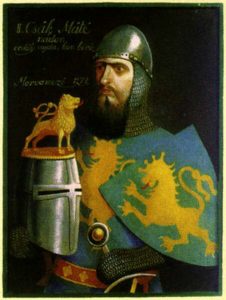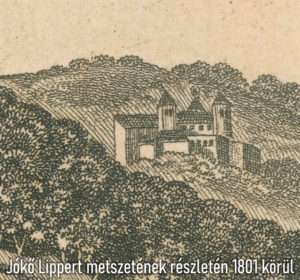Jókő
Jókő (Dobrá Voda, Guttenstein or Gutwasser, Bona Aqua) is a village in the Nagyszombat (Trnava) region of Slovakia. It is situated 25 km north of Nagyszombatt, in the northern part of the Little Carpathians, in the south-eastern part of the Jókői valley, surrounded by mountains and forests. The first information we know is that the area was donated by the Hungarian King András II to Comes Sebes of the Hontpázmány family in 1216.

The estate was given to the Aba family by King Béla IV after the Mongol invasion in 1241 and 1242. A 1262 document describing the boundaries of the estate did not mention the castle, which was built in the second half of the 13th century by Aba the Great (also known as the Beautiful) of the Aba clan.

(Photo: Szöllösi Gábor www.varlexikon.hu)
After the extinction of the Árpád dynasty, King Vencel (László) gave most of Trencsén and Nyitra counties to Csák Máté. The Aba family also sided with Csák Máté against King Károly Róbert. Aba the Great fell in the battle of Rozgony on June 15, 1312, where King Károly was victorious. The castle of Jókő was inherited by Comes Miklós, the son of Aba the Great.

The castellan Mouka of Jókői rebelled and had Aba Miklós maimed and blinded for unknown reasons. Csák Máté demanded the surrender of the castle from Mouka and Lövő István, the lieutenants of the castle, promising impunity in return. His troops surrounded the castle and in his document (“sub castro Joku”) dated September 26, 1316, Csák Máté granted free retreat to all, especially to the sons of Lampert and Kázmér, who did not want to stay in his province, under the castle of Jókő. He made full reparation to Mouka Comes for all the damages he had suffered during the present war and restored his movable and immovable property in full, together with those whom Mouka Comes had named. Jókő has fallen into the hands of Csák Máté.

In November 1317, King Károly Róbert conquered the castle of Komárom from Csák Máté after two months of siege. Sometime later, István of Jókő surrendered the castle of Jókő to Földváry János, the leader of King Károly Róbert. In 1320 Treutul Miklós magister, the Comes of Temes, became the royal castellan of Jókő, and after he was appointed the Comes of Pozsony in 1323, Sár Domokos, the Comes of Temes, became the royal castellan. In 1328 Turrukus / Turkus was appointed sub-lieutenant of Jokw (“Joukou”), who committed a crime of despotism.

(Photo: Szöllösi Gábor www.varlexikon.hu)
Jókő was a royal castle until 1385, when King Zsigmond gave it to his cousins, the Moravian margraves Jodok and Prokop, as a pledge for their military support. In August 1390, Zsigmond was forced to retake the castles from Prokop in a campaign, which in the case of Jókő meant a siege. In 1392 Miklós was the castellan of the castle.

(Photo: Szöllösi Gábor www.varlexikon.hu)
In 1394 Zsigmond donated Jókő, Berencs, and Korlátkő to the voivode Stibor, in addition to his previous donations. The voivode could rightfully call himself the lord of the Vág River. After he died in 1414, his son Stibor the Younger inherited his vast property.

After the death of Stibor Jr. in 1434, Zsigmond succeeded in 1435 to get it back into the possession of the crown, despite the will of the lord of the manor, except for the large estates of Árva Castle. In 1436 Zsigmond donated it to Mihály Országh Guthi, the treasurer.

On 13.02.1442 in the military camp near Pozsony, Országh Mihály and Országh János made a pact to inherit the castles of Jókő (“Jokw”) and Csejte (“Cehte”). When Cillei Ulrik besieged Szakolca in 1450, his troops also set fire to the villages of the Jőkő estate. In 1452 Lancsár, Dejte, Alsólopassó, Radosóc, and Vitenc belonged to the Jókő estate.

Palatine Perényi Imre gave judgment in the suit between two claimants: The first of them was Margit, the daughter of Podmaniczky János, the chief chamberlain, born from the granddaughter of Palatine Ország Gúti Mihály. The second was Borbála, the granddaughter of Palatine Ország Mihály, and Zsigmond. Perényi left it to the Buda chapter to take further action, and they were supposed to help Podmaniczky Margit to take possession of the castle of Szomolya, the castles of Cseszte (* this is not the castle of Vöröskő, but Csejte), Jókő (“Jokew”), Tapolcsány, Surány in the county of Nyitra, Szécsény, Hollókő in the county of Nógrád and Sirok in the county of Heves and to levy a fine of six marks.

In 1555 a record showed that there were only 14 pounds of gunpowder in Jókő Castle. With the death of Országh Kristóf in 1567, Jókő Castle returned to the crown. In 1568 Lancsár, Dejte, Alsólopassó, Radosóc, Vitenc, Oszuszkó, Cseterőc, and Köcsény belonged to the Jókő estate.

In 1569, Balassa János, the chief captain of Zólyom – the father of Balassi Bálint – was arrested by the king for his involvement in a conspiracy against the king. Swetkovich Kata, the wife of Batthyány Ferenc, did her best to get Jókő for herself and her family from the king. On April 14, 1569, she went to the king with her request, and when her efforts to get Jókő failed, she asked for the castle of Kőszeg. In the end, Choron János received Jókő (‘castrum nostrum Jókő comitatu Nitriensis’) as a pledge from the treasury for 52,000 forints, and a few years later Kőszeg as well.

In 1573, at the meeting of the Nyitra County on September 2, it was ordered that 25 infantrymen should be kept in Jókő Castle. The castle and manor were in the hands of the Choron family until 1579, when Illésházy István and Krusith János, on behalf of Emperor Rudolf, began negotiations with Choron to pay 75,000 forints instead of the previous 54,000 forints. Choron refused, so he returned the estate to the court for 54,000 forints, which sold it to Ungnád Kristóf for 70,000 forints.

After Ungnád died in 1589, the castles of Szomolány and Jókő passed to his daughter Ungnád Anna and her husband, the Croatian Bán (Duke) Erdődy Tamás. Sometime after 1606, Erdődy Tamás transferred the Szomolány estate to his second son Kristóf. According to a document, Erdődy Kristóf took over the castles of Szomolány and Jókő in a dilapidated state and spent a lot of money to repair them.

In 1627 the county obligated the Jókő manor to keep five horsemen on permanent duty. The last construction was completed in 1657, during the reign of Countess Amadé Judit, the widow of Erdődy Gábor, according to the plaque above the gate.

During Rákóczi’s War of Independence, Jókő was already in the hands of Károlyi’s Kuruc troops in December 1703. In 1707 Guido Starhemberg attacked Ocskay in July, he entered Szakolca and marched from there against the castles of the Little Carpathians. According to a Kuruc report of June 7, a total of 189 Hajdú soldiers were garrisoned in the castles of Detrekő, Éleskő, Sasvár and Jókő. Starhemberg captured both Éleskő and Detrekő after a brief exchange of fire.

He left a strong guard at Detrekő and then broke the Kuruc siege around Trencsén. Then he made an advance on Jókő and conquered it on July 28. From there he marched under Szomolány and retook it from the Kuruc troops. Esterházy Antal wrote in his camp book: “…the enemy, having taken Detrekő, praesidiated it, and per consequens praesidiated Sassen, Berencs, Jókőt, Szomolya”. Starhemberg placed the towns of Szentgyörgy, Bazin, Modor, the fortresses of Vöröskő, Szomolány, Jókő, Jabloncza, Korlátkő, Detrekő and Éleskő under German guard.

(Source: Szöllösi Gábor www.varlexikon.hu)
The Erdődy family seldom stayed in the castle, most of the time it was occupied by Count Erdődy József († 1787), the royal master butler. In 1762 a fire destroyed most of the castle.

In 1825, Mednyánsky Alajos wrote about the ruined and partly abandoned castle: “Fifty years ago, Count Erdődy János lived within the now bare walls, overgrown with grass and bushes and threatened with rapid destruction. The remains of the roofs over the main parts of the castle can still be seen, but their condition shows that the time when they served a useful purpose is long gone. … a castellan lives here in some of the rooms of the lower castle for the custody of the prisoners…”.

In 1885 the castle and the manor passed into the hands of the Pálffys through Jozefina, the daughter of Count Erdödy Antal. The castle was no longer inhabited, and the crumbling walls were removed by the local population.

Source: Várlexikon https://varlexikon.hu/joko
Dear Readers, I can only make this content available through small donations or by selling my books or T-shirts.
If you like my writings, please feel free to support me with a coffee here:
You can check out my books on Amazon or Draft2Digital, they are available in hardcover, paperback, or ebook:
https://www.amazon.com/dp/198020490X
or at https://books2read.com/b/boYd81


My work can also be followed and supported on Patreon: Become a Patron!http://Become a Patron!

Here are more pictures of Jókő Castle:






















































































